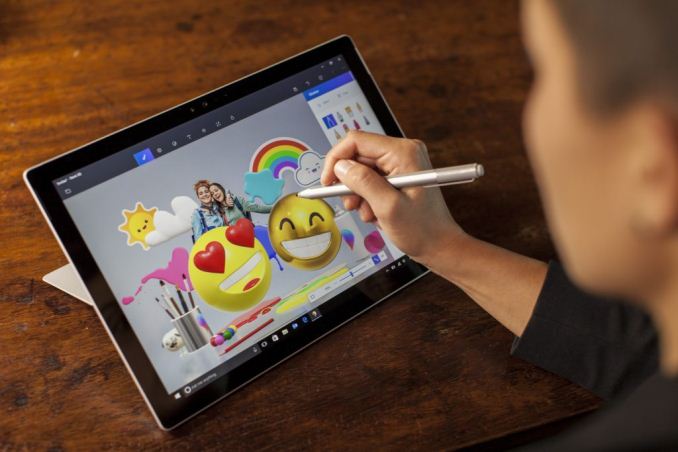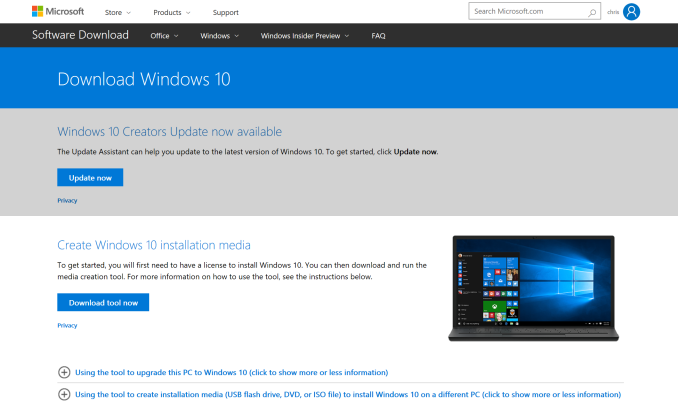The Windows 10 Creators Update Arrives
by Brett Howse on April 25, 2017 8:00 AM EST- Posted in
- Software
- Operating Systems
- Windows
- Microsoft
- Windows 10
Wrapping up and how to get it
This certainly is not a completely comprehensive look at the latest update, and there are many more features under the hood. Regardless, this is a much lighter update than the previous one, which included things like Windows Ink, Windows Subsystem for Linux, and Edge extensions. Still, it’s a solid update, with a lot of nice additions without forcing a re-think of everything. After several updates to Windows 10, it certainly feels like the old Windows servicing method of having a major release every couple of years is an out-dated model.
It would be hard to point a finger at the Creators Update and nail down a single feature that is the key one. Instead, it’s more a collection of smaller updates. There are still plenty of things to be worked on, and hopefully we will see some news out of the Redmond company soon, detailing their direction for their next update.
Really, the biggest thing they need to work on is improving UWP. With the loss of their mobile play, they need to re-focus their efforts on making this work better for the desktop, where the majority of Windows 10 installs are. Xbox is always going to be small by comparison, and even something which has a lot of potential like IoT is going to struggle to compete against the userbase of the PC right now. UWP needs to be improved for these scenarios, and developers need to be sold on why they should switch. This will bring benefits down the road for everyone, but at the moment it’s an untapped market.
Microsoft is going to continue to work on High DPI, and hopefully start to fix their color management woes as well, but at this point both seem like very difficult problems to overcome. This is one of the main issues where legacy application support can be such a burden, but removing this support isn’t the answer either. They are in a tough spot, and have more work to do here. Hopefully we will here some more news on this front soon.
One of the nicest changes with this update is how to get it. Microsoft started rolling out the update over Windows Update on April 11, but it will be a staggered rollout, only targeting known good devices first. That is what they have done in the past, but the big change this time is that you can easily update any computer running the Windows 10 Anniversary Update by running the Update Assistant.
Anyone wanting to force the update to come sooner can go to the Windows 10 Download page and download and run the Upgrade Assistant. It will verify the requirements are met, and trigger the download and install.
With the Windows 10 update model, eventually it will be pushed out to all machines of course, so waiting is always an option, but the new features have been a solid upgrade to Windows 10, if taken in their entirety. Whether you are a web browser, or web developer, there should be something here for you.













69 Comments
View All Comments
Ubercake - Tuesday, April 25, 2017 - link
When it comes to hardware of any kind coming out of Microsoft, count on Microsoft to stop producing and supporting (or in other words "giving up") on it within a couple of years. This Surface Studio is a fantastic idea. The Microsoft Band was a great idea/product. Now no longer supported/produced. The Surface RT was a great idea that wasn't supported after its 3rd year. Mainstream phone apps are still not there. Zune music player (sort of competing with iPod) was gone soon after it was started.The universal windows platform or whatever it won't be called because the hardware just won't be their to support the idea in a few years. Nothing portable device outside of the Surface Pro (all 10 of you Surface Pro users know what I'm talking about!) will be around using the Windows OS in a few years. Why is Microsoft focusing at all on a universal platform that isn't Android- or iOS-based when you know no Microsoft hardware is supported for more than a couple of years? So they can quit it in a couple of years like everything else?
xthetenth - Tuesday, April 25, 2017 - link
The reason the Surface 3 is gone without a successor is because the niche for a lower cost 2 in 1 is an ecosystem now, not a single product.Flunk - Tuesday, April 25, 2017 - link
Intel also pulled the plug on the line of Atom chips the Surface 3 used, leaving Microsoft high and dry. It's possible they'll come up with a new non-pro Surface that uses ARM chips, but that didn't sell all the great the first time.gerz1219 - Tuesday, April 25, 2017 - link
They seem to have a foothold with the Surface Pro, so I wouldn't expect them to kill that any time soon. The problem with Microsoft's hardware ventures is that many of them simply haven't sold very well. They kind of had to give up on the Zune when they had warehouses full of unsold units and it was clear that nobody wanted an alternative to the iPod. Same for Surface RT and the Windows phones.I think any Microsoft device that kind of overlaps with traditional desktops will be well supported in the future. It's their attempts to branch out into mobile that have routinely failed and been abandoned.
Holliday75 - Tuesday, April 25, 2017 - link
I have a Surface Pro. Who are the other 9 users? We should start a club!SaolDan - Tuesday, April 25, 2017 - link
SP4 FTW.Instyle - Thursday, April 27, 2017 - link
The Surface Studio is currently available so I have no idea what you're talking about there. The Surface Pro and Xbox lines have sold in the millions, have plenty of active users and are currently supported. The Zune was supported for quite a long time as well. I think you need to go do some research. The main failed products were Windows Mobile, Surface RT and Microsoft Band.DanNeely - Tuesday, April 25, 2017 - link
"Hopefully we’ll have a chance to dig into this a bit more in the future."Some things in game mode I'd be interested in seeing tested (and might try myself in a few weeks or month when I install the update) are if it helps distributed computing play any nicer with not just games but foreground apps in general. I run several BOINC projects with my spare CPU/GPU cycles. For the most part it just works on the desktop and with simpler games. Games that are GPU heavy or use multiple heavy threads are a problem though because the OS doesn't give enough GPU to keep frame rates up and effectively only lets the game have a single CPU core. Boinc's mitigation options are rather limited; basically I can set it so that when certain apps are running (by executable path) Boinc entirely stops CPU and/or GPU apps. It's all or nothing though (meaning I can't let it leave 4 cores free for my game and continue to do science on the other 4).
More recently I've ran into occasional problems with HTML5 video playback while a GPU apps are running. Years ago I had similar problems with the general desktop and some GPU apps, but that was a much more consistent case. This is far more intermittent and I haven't been able to nail down any sort of pattern yet. May try gaming my browser to see what happens.
dgingeri - Tuesday, April 25, 2017 - link
Why am I so much less enthused about this update than I was about the last big one? It just doesn't seem to have anything I'm interested in.kwall8 - Tuesday, April 25, 2017 - link
The best addition is an address bar in regedit. Only took them 20 years :D